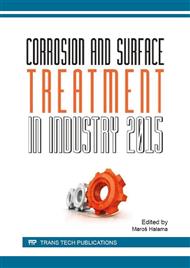[1]
R.W. Revie, Uhlig's Corrosion handbook, third ed., John Wiley & Sons, Hoboken, (2011).
Google Scholar
[2]
V.F. Henley, Anodic oxidation of aluminum and its alloys, Pergamon Press, Exeter, (1982).
Google Scholar
[3]
P.G. Sheasby, R. Pinner, S. Wernick, The surface treatment and finishing of aluminium and its alloys, sixth ed., ASM International, Trowbridge, (2001).
Google Scholar
[4]
D. Basketter, L. Horev, D. Slodovnik, S. Merimes, A. Trattner, A. Ingber, Investigation of the threshold for allergic reactivity to chromium, Contact Dermatitis. 44 (2001) 70–74.
DOI: 10.1034/j.1600-0536.2001.440202.x
Google Scholar
[5]
A.D. Dayan, A.J. Paine, Mechanisms of chromium toxicity, carcinogenicity and allergenicity: Review of the literature from 1985 to 2000, Hum. Exp. Toxicol. 20 (2001) 439–451.
DOI: 10.1191/096032701682693062
Google Scholar
[6]
S.A. Katz, H. Salem, The toxicology of chromium with respect to its chemical speciation: A review, J. Appl. Toxicol. 13 (1993) 217–224.
DOI: 10.1002/jat.2550130314
Google Scholar
[7]
V.S. Sastri, Green corrosion inhibitors: Theory and practice, John Wiley & Sons, Singapore, (2012).
Google Scholar
[8]
Z. Szklarska-Śmiałowska, Inhibitory korozji metali, Wydawnictwa Naukowo-Techniczne, Warsaw, (1971).
Google Scholar
[9]
E. Ghali, R.W. Revie, Corrosion resistance of aluminum and magnesium alloys: Understanding, performance, and testing, John Wiley & Sons, Hoboken, (2010).
Google Scholar
[10]
A.Y. El-Etre, Inhibition of acid corrosion of aluminum using vanillin, Corr. Sci. 43 (2001) 1031–1039.
DOI: 10.1016/s0010-938x(00)00127-x
Google Scholar
[11]
M.A. Amin, Q. Mohsen, O.A. Hazzazi, Synergistic effect of I− ions on the corrosion inhibition of Al in 1. 0 M phosphoric acid solutions by purine, Mater. Chem. Phys. 114 (2009) 908–914.
DOI: 10.1016/j.matchemphys.2008.10.057
Google Scholar
[12]
A.M. Abdel-Gaber, E. Khamis, H. Abo-ElDahab, S. Adeel, Inhibition of aluminium corrosion in alkaline solutions using natural compound, Mater. Chem. Phys. 109 (2008) 297–305.
DOI: 10.1016/j.matchemphys.2007.11.038
Google Scholar
[13]
A.I. Ali, N. Foaud, Inhibition of aluminum corrosion in hydrochloric acid solution using black mulberry extract, J. Mater. Environ. Sci. 3 (2012) 917–924.
Google Scholar
[14]
E.E. Oguzie, Corrosion inhibition of aluminium in acidic and alkaline media by Sansevieria trifasciata extract, Corr. Sci. 49 (2007) 1527–1539.
DOI: 10.1016/j.corsci.2006.08.009
Google Scholar
[15]
M. Sangeetha, S. Rajendran, J. Sathiyabama, a Krishnaveni, Inhibition of corrosion of aluminium and its alloys by extracts of green inhibitors, Port. Electrochim. Acta. 31 (2013) 41–52.
DOI: 10.4152/pea.201301041
Google Scholar
[16]
J.W.J. Silva, E.N. Codaro, R.Z. Nakazato, L.R.O. Hein, Influence of chromate, molybdate and tungstate on pit formation in chloride medium, Appl. Surf. Sci. 252 (2005) 1117–1122.
DOI: 10.1016/j.apsusc.2005.02.030
Google Scholar
[17]
X. Li, S. Deng, H. Fu, Sodium molybdate as a corrosion inhibitor for aluminium in H3PO4 solution, Corr. Sci. 53 (2011) 2748–2753.
DOI: 10.1016/j.corsci.2011.05.002
Google Scholar
[18]
K.C. Emregül, A.A. Aksüt, The effect of sodium molybdate on the pitting corrosion of aluminum, Corr. Sci. 45 (2003) 2415–2433.
DOI: 10.1016/s0010-938x(03)00097-0
Google Scholar
[19]
R.L. Twite, G.P. Bierwagen, Review of alternatives to chromate for corrosion protection of aluminum aerospace alloys, Prog. Org. Coat. 33 (1998) 91–100.
DOI: 10.1016/s0300-9440(98)00015-0
Google Scholar
[20]
C. -S. Liang, Z. -F. Lv, Y. -L. Zhu, S. -A. Xu, H. Wang, Protection of aluminium foil AA8021 by molybdate-based conversion coatings, Appl. Surf. Sci. 288 (2014) 497–502.
DOI: 10.1016/j.apsusc.2013.10.060
Google Scholar
[21]
A. Hamdy, A. Beccaria, P. Traverso, Corrosion protection of AA6061 T6-10 % Al2O3 composite by molybdate conversion coatings, J. Appl. Electrochem. 35 (2005) 467–472.
DOI: 10.1007/s10800-004-8329-3
Google Scholar
[22]
A. Bielański, Podstawy chemii nieorganicznej, Wydawnictwo Naukowe PWN, Warsaw, (2013).
Google Scholar
[23]
C.L. Rollinson, The chemistry of chromium, molybdenum and tungsten, Pergamon Press, (1975).
Google Scholar
[24]
M.T. Pope, A. Müller, Polyoxometalate chemistry: An old field with new dimensions in several disciplines, Angew. Chem. Int. Ed. 30 (1991) 34–48.
DOI: 10.1002/anie.199100341
Google Scholar
[25]
S.R. Crouch, H. V Malmstadt, A mechanistic investigation of molybdenum blue method for determination of phosphate, J. Am. Chem. Soc. 39 (1967) 1084–1089.
DOI: 10.1021/ac60254a027
Google Scholar


